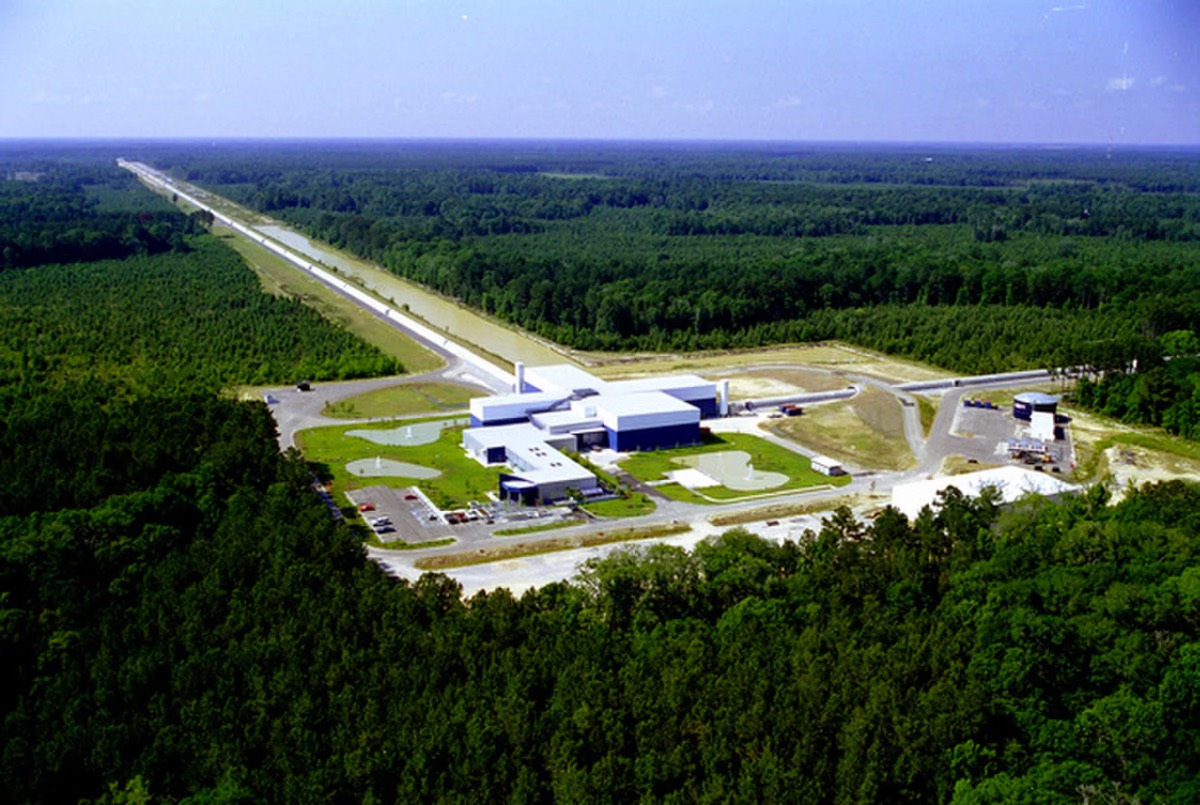To Hunt Gravitational Waves, Scientists Had to Create the Quietest Spot on Earth
The largest physics detector on Earth really, really hates noise.

LIVINGSTON, La. — About a mile and a half from a building so big you can see it from space, every car on the road slows to a crawl. Drivers know to take the 10 mph (16 km/h) speed limit very seriously: That's because the building houses a massive detector that's hunting for celestial vibrations at the smallest scale ever attempted. Not surprisingly, it's sensitive to all earthly vibrations around it, from the rumblings of a passing car to natural disasters on the other side of the globe.
As a result, scientists who work at one of the LIGO (Laser Interferometer Gravitational-Wave Observatory) detectors must go to extraordinary lengths to hunt down and remove all potential sources of noise — slowing down traffic around the detector, monitoring every tiny tremor in the ground, even suspending the equipment from a quadruple pendulum system that minimizes vibrations — all in the effort to create the most "silent" vibrational spot on Earth.
"Everything is about noise hunting," said Janeen Romie, detector-engineering group lead at the LIGO detector in Louisiana.
Why are LIGO physicists so obsessed with eliminating noise and creating the most vibration-free place on the planet? To understand that, you need to know what gravitational waves are and how LIGO detects them in the first place. According to general relativity, space and time are part of the same continuum, which Einstein called space-time. And in space-time, rapidly accelerating massive objects can produce gravitational waves, which look like the ripples that radiate outward when a pebble is dropped onto the surface of a pond.These waves reveal the stretching and contraction of the fabric of the cosmos itself.
Related: 8 Ways You Can See Einstein’s Theory of Relativity in Real Life
How do you measure changes in space-time itself, when any measuring device would experience those same changes? The ingenious solution is what's known as an interferometer. It relies on the fact that gravitational waves stretch space-time along one direction, while contracting it along the perpendicular direction. Think of a buoy on the water: When a wave passes, it bobs up and down. In the case of a gravitational wave radiating across Earth, everything oscillates ever so slightly back and forth, instead of up and down.

LIGO's detector is made up of a laser light source, a beam splitter, several mirrors and a light detector. The light leaves the laser, gets split into two perpendicular beams by a beamsplitter, then travels equal distances down the arms of the interferometer to two mirrors, where the light gets reflected back down the arms. Both beams then hit the detector, which is placed opposite one of the reflecting mirrors. When a gravitational wave passes through the interferometer, it makes one of the arms slightly longer, and the other slightly shorter, because it stretches space along one direction while compressing it along another.This infinitesimally small change registers in the pattern of light hitting the light detector. LIGO's level of sensitivity is equivalent to "measuring the distance to the nearest star (some 4.2 light-years) to an accuracy smaller than the width of a human hair," according to the LIGO collaboration website.
Sign up for the Live Science daily newsletter now
Get the world’s most fascinating discoveries delivered straight to your inbox.
To be able to detect that hair's width wave, scientists go to extreme lengths to eliminate any potential disturbances to this finely tuned setup, said Carl Blair, a postdoctoral researcher at LIGO who studies opto-mechanics, or the interaction of light with mechanical systems.
To start, the 2.5-mile-long (4 kilometers) arms are in one of the world's most perfect vacuums, meaning it's almost molecule-free, so nothing can interfere with the beam's path. The detectors are also surrounded by all sorts of devices (seismometers, magnetometers, microphones and gamma-ray detectors, to name a few) that measure disturbances in the data and remove them.
Related: Einstein’s 1919 Solar Eclipse
Anything that could interfere with or be wrongfully interpreted as a gravitational-wave signal must also be hunted down and eliminated, Blair said. That includes imperfections within the detector itself —- what's known as noise —- or non-astrophysical disturbances that get picked up by the instrument —- what are known as glitches. Physicists must even account for the vibrations of the atoms that make up the detector's mirror and the random fluctuations of the current in the electronics. On a larger scale, glitches can be anything from a passing freight train to a thirsty raven.
And glitches can be really tricky to nail down. When Arnaud Pele joined the detector- engineering team at LIGO, he was tasked with figuring out where an especially pesky disturbance was coming from: the instruments that measured the motion of the ground around the gravitational wave detectors were registering a constant spike, and no one knew why. After several months of dogged sleuthing, he found the culprit: an unassuming rock lodged between the ground and some mechanical springs under a ventilation system. Because of the rock, the springs couldn't prevent the ventilator's vibration from showing up in the detector, causing the mystery signal. "It's a really fun part of my job, doing this detective stuff," Pele said. "Most of the time, it's simple solutions." In the search for infinitesimally small vibrations from the far reaches of the universe, the real work can be very down to Earth.
Most important, perhaps, there are three detectors: Besides the one in Louisiana, there's one in Hanford, Washington, and a third in Italy: "If something is real [...] it has to look the same in all the detectors," said LIGO collaboration member Salvatore Vitale, assistant professor of physics at MIT. If it's a freight train or a rock lodged under a spring, then it will only show up in one of the three detectors.
With all these tools and some very sophisticated algorithms, scientists are able to quantify the likelihood that a signal is indeed a gravitational wave. They can even calculate the false alarm rate for a given detection, or the possibility that the exact signal would appear by accident. One of the events from earlier this summer, for instance, had a false alarm rate of less than once in 200,000 years, making it an extremely compelling candidate. But we'll have to wait until the final verdict is out.
The reporting for this article was partially supported by a grant from the National Science Foundation.
- 9 Ideas About Black Holes That Will Blow Your Mind
- The 12 Strangest Objects in the Universe
- The Biggest Unsolved Mysteries in Physics
Originally published on Live Science.










